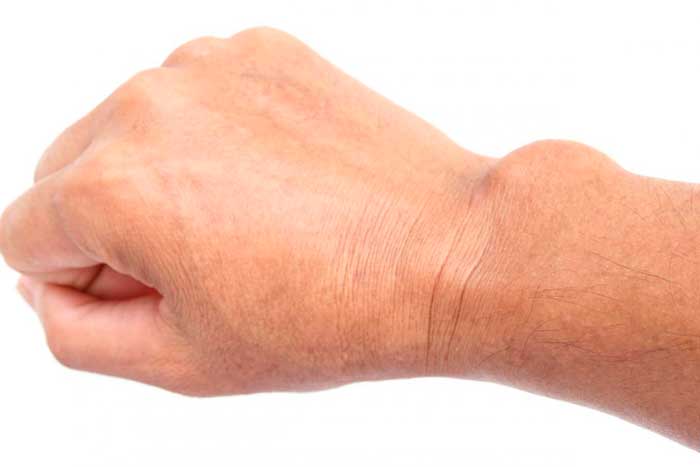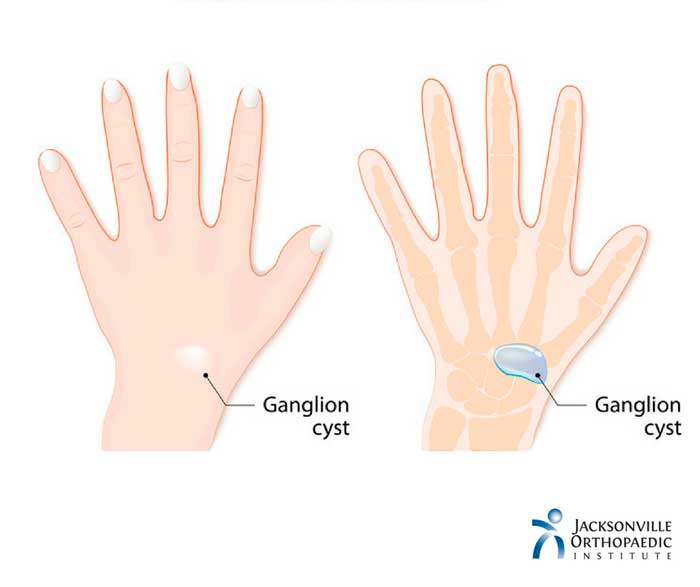 Of course, you are familiar with the situation when a cyst appears on the bone of the wrist. It appears unexpectedly, it does not hurt, but frightens you with uncertainty. People apply plantain to such places, rub them with tinctures, but this is useless. Except the wrist, a similar lump may appear under the knee or in other parts of the body. These formations are called ganglion cysts. Why do they appear, are they dangerous and how can they be treated?
Of course, you are familiar with the situation when a cyst appears on the bone of the wrist. It appears unexpectedly, it does not hurt, but frightens you with uncertainty. People apply plantain to such places, rub them with tinctures, but this is useless. Except the wrist, a similar lump may appear under the knee or in other parts of the body. These formations are called ganglion cysts. Why do they appear, are they dangerous and how can they be treated?
What is a ganglion cyst?
Movements of our arms, legs and all other parts of the body occur in the joints – the joints of the bones. To reduce friction in the joint, nature came up with this: the ends of the bones in the joint are covered with smooth cartilage, and between the cartilages there is articular or synovial fluid. Smooth cartilage friction in a fluid medium facilitates movements. Along the edge of the cartilages, a sheath membrane is attached to the bones. This is a joint capsule which prevents synovial fluid from flowing out. Synovial fluid is water in which a small amount of salts, proteins and carbohydrates are dissolved. It is formed, renewed and absorbed by the joint capsule, or the synovial membrane.
Another common place of friction in the body is long tendons, which muscles use to set the bones in motion. These tendons are also found in the synovial membrane, and the synovial fluid is also in the membrane.
If the joint pressure is constantly increased, and the capsule is weak and thinned in some place, it can stretch out in the form of a pouch connected to the rest of the capsule with a thinner part. In this pouch, normal circulation of the synovial fluid is disturbed, water is strongly absorbed from it, and as a result the pouch is made of the synovial membrane filled with jelly. This is a ganglion cyst.
Thus, a ganglion cyst is a benign tumor bounded by a capsule and filled with a clear liquid. More rarely, ganglion cysts get detached from the membrane, and extremely rarely they occur even inside the skull.
Are ganglion cysts dangerous?
Most often, ganglion cysts are safe: they do not degenerate into cancer, they do not suppurate, and do not hurt. The exception is made in rare cases, when big ganglion cysts put pressure on the nerves or vessels adjacent to them, or if the cyst is inside the skull. Most often, ganglion cysts are only a cosmetic defect. Sometimes they are very noticeable or can also interfere with putting on a shoe or a bracelet.
It must be remembered that a ganglion cyst is always secondary and that the reason for its appearance is the ill health of the joint from which it grew. An experienced surgeon and/or orthopedic traumatologist will help solve the problem.
Why do they appear?
In order for a ganglion cyst to appear, a combination of two factors is enough: constantly increased pressure in the joint and local weakness of its capsule. The weakness of the joint capsule may be caused by a trauma or previous inflammation. It may be a sign of congenital weakness of the connective tissue. Moreover, the weakness of the connective tissue is easy to identify: it can also manifest itself with myopia, varicose disease, hemorrhoids, or flat-footedness. This condition is called connective tissue dysplasia. It is not a disease, but a feature of the body.
Constant increased pressure is characteristic of leg joints that carry the main body load, the ankle and knee joints (Baker’s cyst – posterior ganglion cyst of the knee joint – is one of the favorite cyst locations), as well as the wrist and hand joints (the result of writing, using the keyboard, playing the piano, carrying bags and other lasting loads).
Do I need to delete them?
Intracranial cysts, as well as ganglion cysts that cause squeezing of the surrounding structures, must be removed. Fortunately, this happens very rarely. Most often, ganglion cysts are removed at the request of their owners, who must first consult with a specialist. It often happens that cysts interfere, for example, with wearing watches or cause cosmetic discomfort.
What doctor should I contact to remove the cyst?
Ganglion cysts are formed lumps of the synovial membrane. Unfortunately, the stretched synovial membrane does not shrink back. Cysts are removed by surgeons or orthopedic traumatologists. Appealing to doctors specializing in other fields is meaningless, and resorting to traditional medicine is dangerous.
The consequences of inaction, or when it is better not to touch the ganglion cyst
If the cyst is not inside the skull and does not squeeze the surrounding structures, the removal of the cyst is relatively safe. Why is it relatively safe? Because it points to malfunctions in the joint from which it grows. If you do not remove the cyst, you need to examine the joint, are there any other violations in it? Various measures may be necessary: weight reduction may be relevant in case of knee or ankle cysts; finding a place to rest your elbow is good while working with a computer mouse in case of a ganglion cyst of the wrist. Testing the eyesight and the examination of a phlebologist, proctologist and orthopedist could be important to identify other manifestations of weakness of the connective tissue.
It is important to know!
In order not to miss other serious violations that may not be as obvious as a ganglion cyst, it is necessary to thoroughly examine the joint from which it grows before removing the cyst.
Since the ganglion cyst is associated with a joint, removing it under local anesthesia may be uncomfortable — complete anesthesia is preferable. After removal, fixation of the joint is necessary so that the cyst does not grow again.







